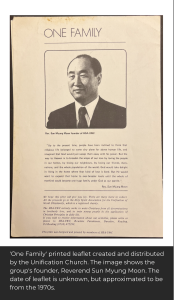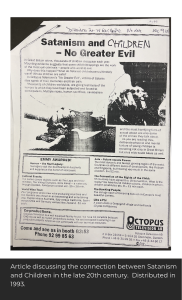Archive and Database
Significance of Collection
Our archive provides an exceptional record of the diversity of new and minority religious groups in twentieth-century Britain. The archive is a unique source in its historical records of the transformations of religious groups, as well as the responses and reactions of the state and other actors to these novel forms of religiosity.
Its existence allows for the potential of longitudinal research on new and minority religiosity, looking thematically at how and why specific groups have grown, transformed, and/or disappeared over time. Furthermore, Inform’s collection also clearly documents the unique British responses (by the government, media, organisations and private citizens) to religions which are seen as challenging social norms and the status quo consensus in areas relating to both ideological beliefs and practices.
Public Accessibility and Research Strengths
The variety and diversity of the collection is unparalleled. It has been specifically designed to capture religious diversity, which encompasses many minority religious traditions which found new forms in Britain with post-war immigration. This is the only collection in Britain which attempts to capture the range and scope of religious phenomena in all its variety.
Inform’s archive has acted as a unique and detailed resource for academics, researchers, government bodies, and families since Inform was founded in 1988. To the right are some examples of specific items within our archive collection.
We are currently fundraising to have our archives properly catalogued and made more directly accessible to the public.
In the meantime, Inform staff can assist enquirers in finding material relevant to their research. We welcome all who are interested in visiting our archives to get in touch.
We always adhering to strict confidentiality and GDPR guidelines with our archival material. See our Database and Archive Confidentiality Policy for more information.
Database
Our database is perhaps the largest source of information on contemporary minority religions in the UK, with more than 5,000 different groups on file. However it is important to understand the database as always incomplete and provisional.
Inform’s database is inclusive – any movement or group that broadly considers questions relating to meaning and purpose in life can be included. This breadth is important to understand the diversity and range of new and minority religious activity and to avoid unfounded generalisations about minority groups. Because of the diversity of social characteristics, beliefs and practices involved in very distinct new and minority religions, it is important to get up-to-date and accurate information on any specific group of interest. Therefore the database is is constant need of updating.
We are currently fundraising to update the database infrastructure to enable more direct access to the public.
Our database provides a further level of information that can accompany collections within our archive. To the left are some up-to-date figures about the movements we currently have on file.
Inform’s archive documents the historical development, changes, and reactions to new and minority religious movements in Britain from 1945-2018. There are also records relating to Inform’s founding, governance and management of commissioned projects. Our archive has helped a diverse number of individuals who all seek information on minority religions. Some of the most common groups of people include:
We have a wide variety of material in our archive that cover a range of topics, including:
Our material covers a diverse range of minority religious movements in Britain that can be categorised as having various religious and spiritual affiliations. Some examples include movements that possess ‘new age’, Christian, Islamic, Buddhist, non-religious, and esoteric traditions. We have extensive files on certain movements, such as:
What is a Minority Religious Movement?
No attempt is made to define too precisely the term ‘minority religious movement’.
How do we Assess Information?
Inform assesses the wide range of often conflicting information it receives using the methodology of the social sciences, in which all its research staff have been trained.
More information
If you have questions relating to the archive, please do not hesitate to get in contact with us via email inform@kcl.ac.uk









